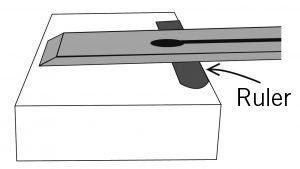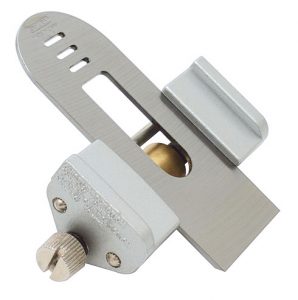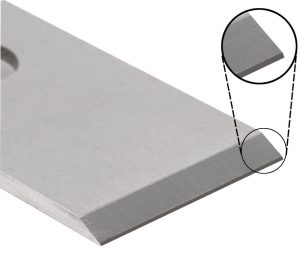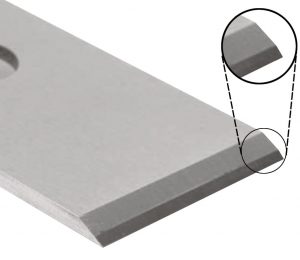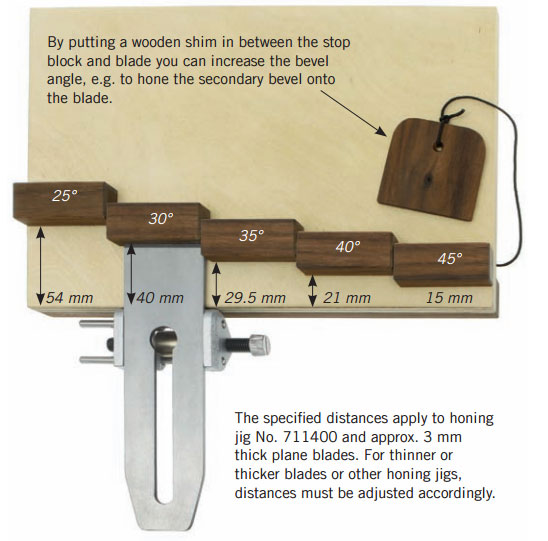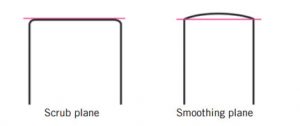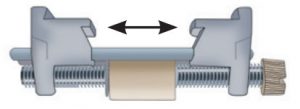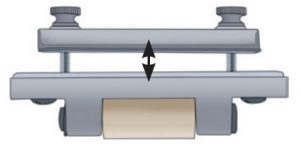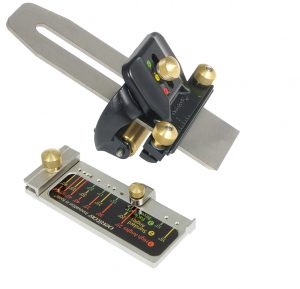Plane Blades
The Lie-Nielsen Method
As a manufacturer of premium metal planes, Lie-Nielsen Toolworks in close collaboration with David Charlesworth has created a sharpening system that allows you to achieve the sharpest cutting edges on plane blades quickly and easily.
First, polish the back of the blade with the so-called ruler trick. This involves placing a thin steel ruler (No. 707270) along the long edge of a fine-grit honing stone, which allows you to polish the very tip of the back of the blade along the opposite long edge of the stone.
Additionally, you hone a micro-bevel onto the blade. This means that a smoothing plane with a 25° bevel, for example, gets a second bevel (e.g. bevel angle 30°) that is a few degrees less acute.
Using the honing jig (No. 711400) and a home made template (see page 27) to set the angles, you
first hone the primary bevel on a rough sharpening stone or diamond block.
Once you have adjusted the sharpening angle to the required final bevel angle (30°, 35°, 40°, 45°), you hone on a secondary bevel on a finer stone (e.g. 1000 grit). This requires only a few passes across the stone. The result is an ultra-thin secondary bevel that needs to be polished on a polishing stone e.g. 6000 grit.
Finally, polish the back with 10-20 passes using the ruler trick. To resharpen, you hone the secondary bevel and polish the back using the ruler trick.
With time, the secondary bevel will become wider and wider, i.e. the surface to polish becomes larger. To speed this up, from time to time you should regrind the primary bevel on the coarsest stone you have to such an extent that the resharpening goes quickly. Alternatively you can use a honing guide and self-adhesive abrasive paper (e.g. No. 707574-707577) stuck on a granite stone plate (No. 711294).
You can also sharpen chisels using the Lie-Nielsen method – but not with the ruler trick. The back of a chisel must remain absolutely flat, as it serves as a guiding surface in precision work.
Template for setting bevel angles
The specified distances apply to honing jig No. 711400 and approx. 3 mm thick plane blades. For thinner or thicker blades or other honing jigs, distances must be adjusted accordingly.
Cambered plane blades
Most planing applications require precisely ground straight cutting edges. There are, however, situations where the sharp outer corners of the plane blade leave steps when planing wider surfaces. In order to avoid this you can grind a slight curvature to the cutting edge or round the corners of the plane blade bevel.
Grinding a slight curvature
As a rule of thumb, the corners must only be rounded slightly more than the shaving is thick – i.e. for a smoothing plane approx. 0.05 mm. When dealing with thicker shavings, e.g. with a scrub plane, the cutting edge is rounded over its complete length.
Sharpening guides with barrel-shaped rollers (e.g. No. 703839) allow for honing slight curves into plane blade edges whilst still maintaining an accurate and consistent bevel angle.
A video with Garret Hack on cambered plane blades is available here.
Sharpening aids
Sharpening aids normally have two jaws and allow for reproducible, precisely straight sharpening of all blades with straight cutting edges. Also suited for short, irregular, conical and Japanese plane blades as well as slightly cambered or skewed blades.
There are two different kinds of sharpening aids:
1. Sharpening aids with side clamp
(e.g. No. 711400, No. 701211, No. 703844)
Properties:
- Only suitable for machine-produced chisels/planes that therefore possess 100 % parallel or angled edges (Western chisels)
- Broad edges cannot be clamped
- Good handling without cumbersome horizontal clamp screws
- Long pressing surfaces to achieve firm attachment
2. Sharpening aids with horizontal clamp
(e.g. No. 703666, No. 707149)
Properties:
- Ideal for chisels/planes that are crafted by hand and therefore do not possess 100 % parallel or angled edges (Japanese chisels)
- Suitable for conical chisels
- Laborious to adjust, as they do not have an angle scale
- For angled bevels as well

